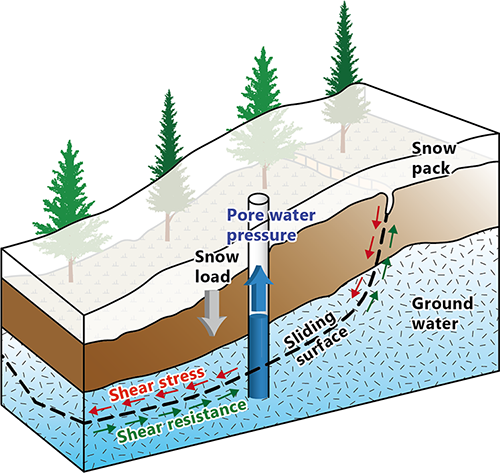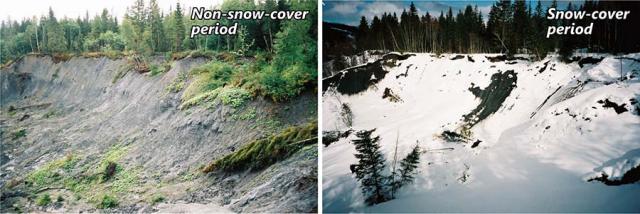Home > Research > Research Results > Research Results 2018 > Snow loading increases the pressure in the saturated zone of landslides
Update:September 26, 2018
Main content starts here.
Snow loading increases the pressure in the saturated zone of landslides
| Article title |
The response of pore water pressure to snow accumulation on a low-permeability clay landslide. |
|---|---|
| Author (affiliation) |
Takashi Okamoto(a), Sumio Matsuura(b), Jan Otto Larsen(c), Shiho Asano(a), Kazutoki Abe(d) (a) Department of Disaster Prevention, Meteorology and Hydrology, FFPRI, Tsukuba, Ibaraki, Japan. (c) University Centre in Svalbard, Longyearbyen, Norway. (d) Nihon University, Fujisawa, Kanagawa, Japan. |
| Publication Journal |
Engineering Geology, 242, 130-141, August 2018, DOI:10.1016/j.enggeo.2018.06.002( External link ) |
| Content introduction |
Increased pore water pressure (groundwater pressure) in mountain slopes occasionally trigger landslides and/or slope failures. Although increases in pore water pressure are mainly caused by infiltration of rainwater and melting snow, an unusual phenomenon can sometimes be observed in regions experiencing heavy snow where the pore water pressure increases during the snow-cover period, when rains and snow melting rarely occur. The reason of such a phenomenon remains unclear although it poses problems for predicting the landslide risk during the snow season. In landslide-prone areas of the snow-covered regions of Norway, with a similar problem, we precisely monitored variation in the pore water pressure over 3years. We found that the pore water pressure showed seasonal fluctuations, increasing in the snow-cover period (December–March), when the snow pack depth increases, and decreasing in spring (April), when the snow pack depth decreases. We observed that snow loading was the main factor for increased pore water pressure during the snow-cover period. When the snow pack presses on the ground with extremely low permeability, the groundwater is subjected to the snow load, thereby increasing the pore water pressure. This phenomenon is similar to compressing a paper carton half-full with juice from above until juice spurts out of the straw. Analyses of the soil from the monitoring sites have shown that the landslide sites were covered with extremely low-permeability clay. Conversely, it was also found that the pore water pressure at high permeability landslides sites did not change under increasing snow loads. Although it is widely known that landslides can be caused by snow melting, this study has demonstrated that snow loading also plays a notable role. The findings of the study will make a significant contribution for predicting the occurrence of landslides in snow-covered regions, whether in Japan or overseas, and may be useful for the development of warning systems for landslide hazards.
Photo1: Landslide site where monitoring was conducted (Roesgrenda, Norway) |
Copyright © Forest Research and Management Organization. All rights reserved.


